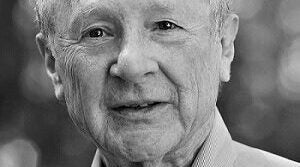In May of 2021, molecular biologist and geneticist Dr. Matthew S. Meselson gifted his scientific papers to the CSHL Archives. After processing was completed in June, they are now available to researchers for the first time. This record of Dr. Meselson’s career—beginning in 1949 while at the University of Chicago and continuing throughout 2019 at Harvard University—contains professional and personal correspondence, laboratory files, and awards and honors. Dr. Meselson’s collection is a testament not only to midcentury scientific discoveries, but also to the highly collaborative network of scientists responsible for those discoveries.
Crystallography and Colleagues
Included among the materials gifted to CSHL are the X-ray crystallography photographs developed in the Meselson-Stahl experiment of 1958. Working with Franklin Stahl and Jerome Vinograd at the California Institute of Technology, Meselson developed the equilibrium density-gradient centrifugation method in order to identify and analyze the densities of giant molecules. Meselson and Stahl then used this new ultracentrifugal method to demonstrate the semi-conservative replication of DNA molecules. Called “the most beautiful experiment in biology” by former CSHL Director John Cairns in conversation with historian of molecular biology Horace F. Judson in 1979, the results of this experiment verified the suggestion first put forward by James Watson and Francis Crick five years earlier, lending important early support for the Watson-Crick model of the DNA molecule.
In 1960, future Nobel laureate Sydney Brenner and François Jacob asked Meselson to join them in conducting a new experiment. Using the same density-gradient method Meselson had developed three years prior, the team demonstrated the existence of messenger RNA in 1961.
Spanning an illustrious career of over seventy years, these papers are an invaluable look into the vibrant community of midcentury scientific work. In addition to the valuable historic and scientific materials, the collection also includes decades of correspondence, both professional and personal, between Meselson and his mentors, colleagues, students, and friends. Of particular interest is Meselson’s ongoing correspondence with Stahl: from the onionskin paper of the late 1950s to modern email, the letters portray a strong and lasting friendship between two revolutionary minds.
Explore
If you’re interested in exploring the Meselson papers, please consult the finding aid for the collection. Dr. Meselson has also participated in the CSHL Oral History project, where you can watch, listen, and read along as he discusses CSHL, life in the sciences, and many other topics.
Dr. Sydney Brenner’s papers are also housed at the CSHL Archives; to explore these materials, please consult the Brenner collection finding aid.
